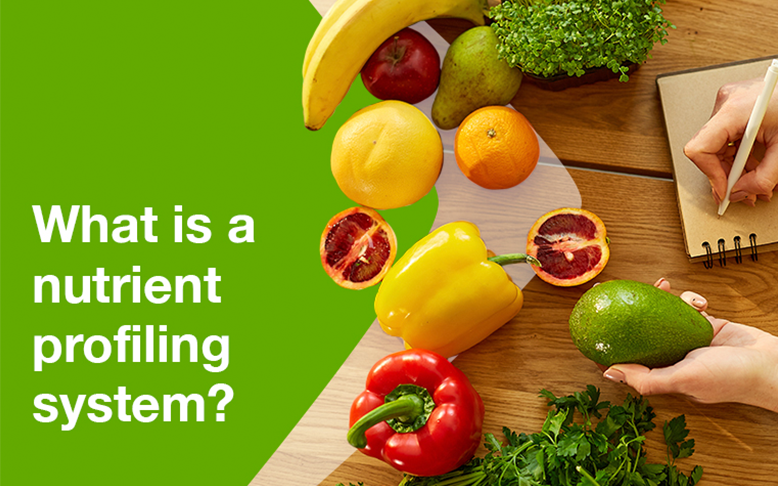What is a nutrient profiling system?
Nutrient profiling (NP) is a scientific method for categorizing food and beverage items based on their nutritional composition3. The World Health Organization (WHO) recognizes NP as a useful public health tool for health promotion and disease prevention, both in developed and developing countries4. By classifying or ranking foods, it differentiates between foods and beverages that are more likely to be part of a healthy diet from those that are less likely (notably those foods that may contribute to excess consumption of energy, saturated fats, trans fats, sugars, or salt).
What is the use of a nutrient profiling system?
The NP system is applied in multiple aspects of food policy ranging in purposes, such as to guide consumers in making healthier food choices, to regulate the promotion and marketing of foods to children, to evaluate the nutritional quality of single foods, and to set qualifying criteria for nutrition or health claims4.
Some countries have already developed and applied different schemes as part of a regulatory system for front-of-pack labeling and restricting food from making claims/identifying products (eligible to bear claims), and part of a voluntary or private systems for consumer education purposes. In food industry systems, this can also be a driver for product reformulation and development of healthier products5-8.
What are the steps in developing nutrient profile models?
Decision steps are necessary when developing a model as NP systems vary in complexity and can be based on different approaches. Depending on the purpose, evidence-based information that supports the link between diet and population health should be the basis for the development of an NP model. In the decision-making process, any decision in one step may influence the outcome in the other steps9.
Multi-step approaches have been proposed in the past4,8,10 and can be summarized under broad headings below:
Decision steps in developing a nutrient profile model
- Deciding the purpose and target population for which the model is to be used
- Deciding on the type of model (i.e., food-category-specific, across-the-board criteria or combination)
- Selecting appropriate nutrients and other food components to include
- Selecting a suitable reference quantity and output of the model (ie. scoring, threshold, or combination) and numbers set for thresholds and/or scores
- When deciding on the scope and exemptions to the model, decisions should be made about which products are covered and excluded. The numbers set for cutoffs can either be based on a pragmatic approach, legislation or derived from dietary recommendations.

Figure 1. Decision steps in developing a nutrient profile model
How do nutrient profiling systems differ in HIC (non-communicable diseases) and LMIC (fortification)?
NP was initially developed in response to obesogenic environments in high-income countries (HIC) which tend to penalize foods with excessive calories, fat, sugar, and salt. However, this context may not be readily applicable in low- and middle-income countries (LMIC) where multiple micronutrient deficiencies and stunting continue to be issues of public health concern.
The NP metrics need to address inadequate intakes of energy, high-quality protein, and still prevalent micronutrient deficiencies such as vitamin A, B vitamins, folate, calcium, iron, iodine, and zinc5,6,10. In this regard, nutrient-dense foods need to be sourced in the context of availability and affordability. Due to the non-affordability of nutrient-dense diets11, NP systems tend to award more favorable scores to more expensive food items10,12 and should therefore be reconsidered in NP models for use in LMIC. Ultimately, the usefulness of NP models will rely on the extent and quality of the available food composition data. To improve the dietary adequacy in these populations, obtaining the nutrient density of fortified foods using the best available data will be necessary.
What are the considerations in the development of a nutrient profiling model in the Philippines? (e.g., nutrients, per serving vs per 100g)
The Philippines is suffering from a triple burden of malnutrition, which comes with a persisting challenge of undernutrition and micronutrient deficiencies along with the emerging challenge of overnutrition13. The model should therefore be based on context- and policy-driven considerations in the light of most recent evidence.
Choice of model type
NP models are based on either a categorical or scoring system. Being able to identify the ‘best-in-class’ items within a given food group, category-specific models are considered easier to adapt or modify than models based on scoring, an important consideration for a country-level model10. By enabling consumers to compare products within food categories and therefore recognizing inherent nutritional differences in food groups, this approach allows people to make informed, better choices14-16.
Balance of Nutrients
The Philippine NP model should not only be directed towards obesity prevention but should also address the still prevalent micronutrient deficiencies in the Filipino children’s diets13,17,18,19. This context highlights the need to capture the nutrient density of foods, including fortified foods, as opposed to energy density alone10.
The inclusion of multiple beneficial nutrients – protein, dietary fiber20,21; key sources of micronutrients that are deficient in the Filipino diet (e.g., iron, zinc, vitamin A, vitamin C)13,19; as well as food products with a significant percentage of fruits, vegetables, nuts, and whole grains21-23, will help encourage a balanced NP model and help shift the emphasis from nutrients to limit to desirable and healthy foods.
| Nutrients to Encourage vs. Nutrients to Limit in the Context of NP Model |
|---|
|
Based on the SAIN-LIM model proposed by National Agency for Food, Environmental, and Occupational Health and Safety (ANSES) of France; SAIN means “score for the nutritional adequacy of individual foods” while LIM refers to “score of nutrients to limit”24 |
In contrast to high-income countries, total fat (as a percentage of energy) remains a shortfall nutrient in the diets of young Filipino children13,19. Therefore, it is also important to pay attention to the dietary fat quality of food products, including polyunsaturated fatty acids and mono-unsaturated fatty acids.
Reference quantity
While the local labeling regulation on nutrient declaration (AO 2014-0030)25 mandates the labeling in serving size specified by the manufacturer, the absence of locally regulated serving sizes and consumption patterns will introduce several difficulties in the country NP model. On the other hand, the 100g/100ml base unit is consistent with existing legislation in the Philippines and used as the reference in the nutrition and health claims covered by BC 2007-002 (Guidelines on the Use of Health and Nutrition Claims)26 based on Codex Alimentarius.
Models based on serving sizes or 100 kcal can be the preferred unit for scoring nutrients to encourage whereas models based on 100 g/ml are for scoring nutrients to limit27. The per-serving basis was shown to be correlated to per 100 kcal unit. Alternatively, a combination of two approaches (e.g., 100g and per serving) can address these limitations.
Concurrent with food-based dietary guidelines
Food-based dietary guidelines are recommendations for healthy eating, framed in terms of foods and food consumption patterns. NP models, on the other hand, classify foods based on their nutrient composition, and this information can be used to help in achieving dietary recommendations.
The country NP model needs to complement and support food‐based dietary guidelines and food regulations6,28-31. This can be further illustrated by modeling studies32,33 where a positive nutritional impact of meeting dairy recommendations in Filipino children demonstrates the need for better food-based strategies for encouraging dairy consumption in the Philippines. With only half of the Filipino children consuming at least one dairy product a day despite the recommendation of one glass of milk or milk product per day, the NP model should set thresholds for dairy products with the consideration to facilitate adherence to the dietary guidelines.
Relevance and validation
Most importantly, model adaptation and development should be appraised and validated against independent measures of a healthy diet. The model also needs to demonstrate that it can serve its intended purpose and deliver positive outcomes on diet and health6,10,20,34.
How can nutrient profiling systems drive PH public health?
Efforts are now underway to adopt the Philippines’ NP by the Department of Science and Technology – Food and Nutrition Research Institute (DOST-FNRI) after being commissioned by the National Nutrition Council (NNC) in 2020. The model will be primarily used to develop policies to restrict the marketing of food and beverages and guide food manufacturers and consumers towards healthier food choices. As in other countries, NP can also guide healthy food procurement in several opportunities in the local food supply chain (e.g., school setting, agricultural policies, local government facilities) and in other sectors of the food system (e.g., taxation policies, social welfare, research)2.
Food reformulation has been recognized as a cost-effective intervention in addressing non-communicable diseases as it does not require significant modifications in consumer behavior and dietary habits15. And while reformulation is mostly recognized in reducing the ingredients to limit (i.e., food product’s content of energy, fat, sugar, and salt), it can also offer fortification of vitamins and minerals, as well as the addition to desirable components in foods such as whole grains, dairy, fruit, nuts, and seeds35-37. While NP is not the definitive solution to increased consumption of nutritious foods, it can undoubtedly drive the country’s public health through strengthened product innovation and reformulation by the food industries.
Delivering a science-based tool like NP has the potential in LMICs in improving food sustainability – encompassing a nutritious and balanced diet, as well as healthy economic and social systems.
And on a lighter side: What is your message to Filipino RNDs?
We need to work hard by acting on the bigger issues toward the SDGs. Our unsteady food systems exacerbate the problem of poor nutrition despite having enough food on the planet. As nutritionist-dietitians, our role is to help strengthen food environments by leading a more sustainable diet and lifestyle and advocating for change to policies that promote the human right to safe, nutritious, and sufficient food in every Filipino.


 Karen Kay Mejos , MSc, PhD
Karen Kay Mejos , MSc, PhD















No comments here yet.